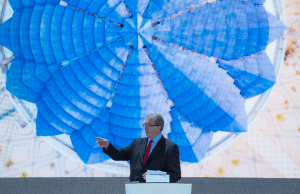TIME TO BITE THE BULLET
The editorial board of Kongres Magazine has been closely following and analysing various sustainability marketing campaigns. It seems their numbers have skyrocketed this year. As it turns out, many of them are misleading and purposefully used by greenwashers to increase sales or improve a company’s reputation. By doing so, they deceive well-intentional consumers and, ultimately, do not contribute to solving ecological and social issues. It is vital to stay aware of the ways in which they attempt to outwit us. Recognising greenwashing is how we can reduce its influence on our choices.
We have decided to prepare a series of articles that will uncover such practices and, hopefully, contribute to a more responsible meetings industry.

Case 12: WHAT YOU CAN MEASURE, YOU CAN MANAGE
Type of greenwashing: Lack of proof to back up claims
Conventa’s green story has taught me a valuable lesson: years of planning, careful consideration, and green endeavours are worthless until we address the elephant in the room. In the case of Conventa, that is measuring carbon footprint after the event according to an internationally-comparable method. What and where we conduct our measurements at an event is imperative. A tonne of theory cannot be compared to a gramme of practice. Often, we come across misleading matrixes that offer the easy route leading nowhere. Among such instant shortcuts, countless certificates have spread like wildfire within the industry. However, only genuine matrixes can help us discern which approach leads to faster development and which methodology may deter us from making progress.
The data we acquired by measuring the carbon footprint at our last Conventa project is priceless. It has enabled us to see the actual image and gain new knowledge that will allow us to grow. Most importantly, having measured the results of our innovative approach, we will now have the tools to develop expertise ourselves.

I must admit that we were taken aback by the results of this year’s measurements. Our subconscious drives us to describe and evaluate ourselves better than we really are. We thus tend to avoid conducting measurements. The sooner we tell ourselves the truth, the sooner we can progress. Often, the truth motivates us to take action.
WHEN DISCUSSING NUMBERS, KNOW-IT-ALLS VANISH
Let’s take a look at the findings of the study of the carbon footprint at this year’s Conventa.
Reducing environmental effects is one of Conventa’s most important objectives. That is why this year, the organisers meticulously measured the carbon footprint of the entire event, which took place from 23 to 26 August 2022 at the Ljubljana Exhibition and Convention Centre and various locations around Ljubljana.
Because we aimed the project to yield precise results, we partnered with the esteemed company ClimatePartner to calculate the carbon footprint. Their calculation comprised an array of sources of carbon footprint. Their innovative methodology and know-how helped optimise countless processes in the execution phase.

A carbon footprint of just over 275 tonnes is equivalent to:
– the carbon stored in 20,033 beech trees
– the summer melt of 751 m2 of Arctic ice
– 269,256 laundry cycles at 60 degrees Celsius
– the production of 20,375 kg of beef
We are well aware that the calculation of the carbon footprint is just the beginning. The purpose of the measurement was to recognise the activities that cause the most greenhouse gas emissions. Having measured the carbon footprint precisely, we can prioritise future measures to improve in line with the project’s 160 sustainable criteria. Conventa will recalculate its carbon footprint in February at Conventa 2023.
CARBON FOOTPRINT STRUCTURE OF CONVENTA 2022
| 88,2% | Transport of participants | 220,765.8 kg |
| 6,1% | Hotel accommodation | 15,188.0 kg |
| 2,5% | Transport of equipment and technical teams | 6,312.5 kg |
| 1,9% | Venue | 4,841.6 kg |
| 0,8% | Catering – food | 2,008.8 kg |
| 0,4% | Catering – drinks | 1,025.9 kg |
| 0,1% | Other equipment and materials | 265.7 kg |
| TOTAL: | 250,408.3 kg | |
| 10% | Safety reserve | 25,040.8 kg |
| TOTAL CARBON FOOTPRINT: | 275,449.1 kg |
As much as 88.2% of the measured carbon footprint resulted from transporting participants to the venue. Ahead of Conventa 2023, we will strive to minimise the carbon footprint related to transport.
We often partake in poorly thought-out public marketing campaigns within the meetings industry. We will not solve the situation solely by planting trees, recycling name badges printed on recycled and biodegradable paper and refillable water stations at renowned international industry congresses. Our efforts should focus on mobility. It is evident that event hybridisation is an excellent choice. Contrary to the belief of numerous logisticians, hybridisation will not diminish our industry. It will foster its growth and make it more adaptable. Hence, we must encourage clients and colleagues to bust the myth that hybrid events are noticeably more expensive and challenging to organise compared to in-person or online events. We must ask ourselves whether we know how to monetise hybrid event forms optimally. Above all, we should advocate for them in terms of sustainable transformation. It goes without saying online attendance is not suitable for all event types (incentives and teambuildings). Not least, we must ask ourselves if an event’s positive social and economic effects can outweigh a part of its negative environmental impact.
The most evident sign of greenwashing is communication regarding green measures that contain no factual data about the carbon footprint of a particular activity. To illustrate, what will the recycling of name badges bring at this year’s biggest event within the industry? Does the encouragement of sustainable mobility actually bear fruit? For starters, event organisers should at least calculate the carbon footprint of their event and support their results by collaborating with a recognised institution.
Note: We look forward to your opinion about greenwashing. Feel free to comment and send us further examples. We will inspect them and write additional articles about them in Kongres Magazine.

Environmentalist Jay Westerveld coined the term “greenwashing” in 1986. While on an expedition to Samoa, he was greatly upset by the hotel sign concerning the reuse of towels. He concluded that its purpose was solely a strategy to lower expenses instead of the hotel’s sustainable and responsible aspirations.
Westerveld was the first to use the term greenwashing in his expert article, and the rest is history. The term has survived till today and encompasses all areas of sustainability, including gender equality, poverty, hunger, health, education, paid work etc.
There are several typical examples of greenwashing. They have been around for some time, yet, we continue to be duped by them. We have summarised the most typical examples of greenwashing below:
1. Presenting information selectively
An example of greenwashing is emphasising environment-friendly information whilst withholding negative information. A typical example is ignoring the carbon footprint of event transfers which can amount to 75% of an event’s entire carbon footprint.
2. Lack of proof to back up claims
Let us suppose a company claims their event is green or eco-friendly but does not enclose any concrete proof. They should at least calculate their event’s carbon footprint and support it with a certificate issued by an official institution.
3. Ambiguity and vagueness of claims
Another way of misleading is using loose and undefined terms that are nearly impossible to understand in one way. A recurring example, for instance, is stating that an event is carbon-neutral without elaborating what that stands for.
4. Deceiving and irrelevant labels
Companies will often refer to certificates and labels that, in fact, do not exist or are misleading. Lately, there have been cases of green venue finders with no real foundation. This type of deception is embodied by companies that sell “products without CFC”, even though chlorofluorocarbons are forbidden by law.
5. Highlighting the lesser evil
Event organising is environmentally unfriendly. Hence, the claim that one event is greener than another is plainly false.
6. Selling lies
On occasions, companies choose to proclaim lies. Making false claims, certificates, and inventing facts leads to misleading customers.
7. Meaningless labels
Certificates, labels and awards can often have little or no meaning. In some cases, organisations even award themselves with certificates or endorsements not backed by any authority.
There are even cases when companies tell outright lies. Sooner or later, such practices are exposed, and information about them spreads like wildfire.
Slovenian Advertising Code on greenwashing
What the Slovenian Advertising Code says about greenwashing:
Article 17: ENVIRONMENTAL ARGUMENTATION
17.1
Advertising that includes environmental argumentation should be presented in a manner that does not exploit the consumer’s environmental concern or his potential lack of knowledge about environmental themes. It should not contain claims or visual representations that could, in any way, mislead the consumers about products’ benefits from an environmental viewpoint or the environmental activities the advertiser will conduct. Messages can apply to concrete products or activities; they cannot, however, unjustifiably imply that they cover all activities of a company, group or sector.
17.2
Claims concerning environmental preservation are not allowed to be used groundlessly. Claims such as environment-friendly, completely biodegradable, greener, friendlier or organic may be acceptable, provided the advertisers prove their truthfulness.
17.3
Comparisons are acceptable if the advertisers can prove that their product improves from an environmental perspective compared to their own or competitors’ products.
17.4
Claims and comparisons can be misleading if they leave out important information.
17.5
When scientific opinions are divided, and the results are not final, the advertisement has to make that clear. An advertiser cannot quote that their claim is generally accepted if that is not the case.
17.6
In case a product never had any evidently harmful effects on the environment, the advertisement cannot suggest that its structure was altered to make it more environment-friendly. It is, however, lawful to quote claims about a product whose composition has been altered or has been used hitherto without ingredients that are known to be harmful to the environment.
17.7
The use of lesser-known expert terms should be avoided. If the use of a scientific term is unavoidable, its meaning should be clear and understandable or additionally explained.
17.8
A broader explanation of the most commonly used claims and terms is defined in the International Chamber of Commerce Code of Advertising and Marketing Practices.
For more information please check: https://iccwbo.org/content/uploads/sites/3/2018/09/icc-advertising-and-marketing-communications-code-int.pdf.














